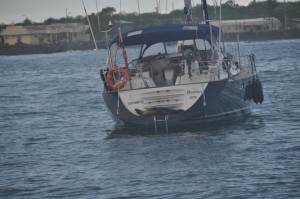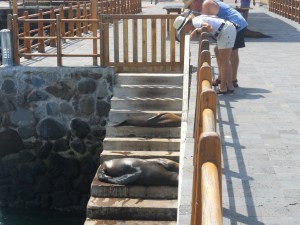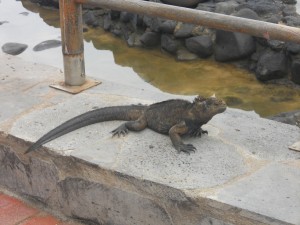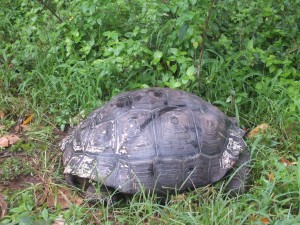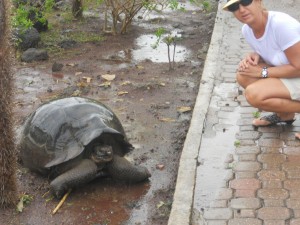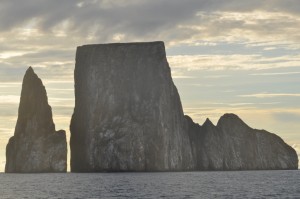There has been an overdose of pictures of me in recent blogs so I feel safe enough now to have mostly pictures of wildlife in this one. And this is the Galapagos after all so where better to do this from.
San Cristobal island was where we first made landfall in the Galapagos. The Arc had pre-arranged with the authorities that this is where all the Arc boats would clear customs and be inspected by the National Park agency. At about 7.00am we were boarded by 6 officials, carrying a mountain of paperwork. All cabins were inspected so an early rise for the crew. We were told we had to peel all the oranges we brought with us and hand the peels over. Something to do with fruit flies. We had brought dozens of oranges and tangerines with us so this was no small task. Other than that the rules were very straight forward. We are not allowed to leave the dinghy ashore. It can be used to ferry people in and out but must not be left unattended. So, rather than leave anyone behind, we decided not to use the dinghy at all and use water taxis to get in and out. We are only allowed to visit 4 of the 5 populated islands and we must declare which ones in advance. (There are 13 islands in all). We are not allowed to anchor anywhere else in the Galapagos but can take organised tours.
Finally, after about 2 hours of paperwork, instructions etc we were allowed to go ashore. My first impression was one of shock. I expected to see a barely habited island. In fact the population of San Cristobalis 6,000. There are shops, bars, restaurants, travel agencies, dive centres….. However, it was clear from first sight that the island is owned by the wildlife and humans are just about tolerated. We arrived at the dock in the water taxi only to find the steps up to land from the water were covered with sea lions who made no attempt to get out of our way. On land, there were sea lions resting on park benches, under trees, in the children’s playground. Traffic was stopping regularly to let marine iguanas cross the road. The seals also climb aboard the boats at night and sleep in the cockpit. The first night we arrived back on board, we thought this was cute – until we got the smell and found huge poops on the deck. Seas lions are incredibly smelly.
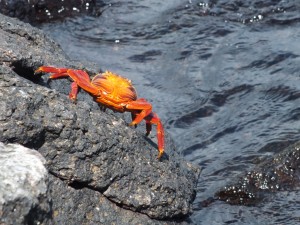
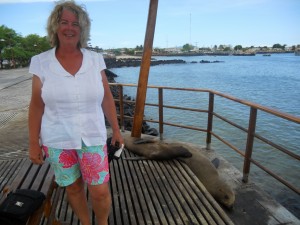 Rather than take an organised tour on day one, we instead hired a taxi to take us around the island and point out the main features to us. He turned out to have a little English and was in no hurry anywhere. So in fact we had our own private tour. San Cristobal is the only island with its own supply of fresh water. This is because a fresh water lake has formed in the crater of an extinct volcano. This was our first taxi stop. We trudged to the top of the volcano, in the lashings of rain. It is the wet season here and of course we were not equipped for a warmer version of Irish weather. But after 5 days on a boat it is great to stretch the legs – even in the rain.
Rather than take an organised tour on day one, we instead hired a taxi to take us around the island and point out the main features to us. He turned out to have a little English and was in no hurry anywhere. So in fact we had our own private tour. San Cristobal is the only island with its own supply of fresh water. This is because a fresh water lake has formed in the crater of an extinct volcano. This was our first taxi stop. We trudged to the top of the volcano, in the lashings of rain. It is the wet season here and of course we were not equipped for a warmer version of Irish weather. But after 5 days on a boat it is great to stretch the legs – even in the rain.
We also visited a tortoise reserve which while interesting was a bit of a disappointment. I was expecting tortoises big enough to ride on, should you be so cruel. But the largest of these was only about 3 ft wide and 18 inches high. There are 3 different types of tortoise in Galapagos and this island has the smallest type. The reason the reserves are needed is because in the early 1800’s, over a period of just 30 years, 100,000 tortoises were removed from the islands by passing ships. The population is still recovering. The sailors discovered that if you laid a tortoise on its back, it could live for up to 1 year without eating. So, on the way to the South Pacific, Australia etc, they would stop off in Galapagos, collect tortoises and stack them on top of each other below decks. Puts our large collection of oranges in the ha’penny-place!!
Each of theGalapagos islands has quite different vegetation and wildlife. San Cristobal is mainly covered in trees and they grow a lot of fruit here. Food cannot be transported from one island to the other so you tend to eat whatever is grown locally. Sea lions are the predominant animal here and because of the tree coverage, finches and mocking birds the predominant birds.
One trip we took while here was a boat tour out to Kicker Rock. It is a massive volcanic rock about 5 miles offSan Cristobal. It just rises up out of the water and has a wide cleft in it. We were dumped out of the tour boat, in our snorkelling gear, into about 80 meters of water and told to swim through the gap. The idea was that we would swim with the current and the boat would pick us up on the other side. Except the skipper of the boat got his tides wrong and we struggled against the current for about 15 minutes before giving up. By the time we got properly organised to swim in the right direction, with the current, I was too tired to risk getting back in the water. I believe those who did saw plenty of hammer-head sharks along the way, so I’m just as glad I stayed on board. While I was fighting against the current I was accompanied along the way by a massive sea-turtle and this was good enough for me.
Within a couple of days, all the other Arc boats had arrived. It was good to catch up with the crews of other boats and hear tales of their trip thus far. While onSan CristobalI got the sad news that my dog had died. Those of you who are not dog lovers won’t understand how attached we humans are to our dogs. She had a really sweet nature and was great company for me over the years. (She also helped to keep me fit). So it was devastating news which won’t really become a reality until I’m back home. The one consolation is that she was being well looked after and died so suddenly she didn’t suffer.
Next stop isSanta Cruzwhere we will base ourselves for about 8 days and from there will join a couple of tours to seeSanta Feand Isabella. We expect to see land iguanas, saddle-back tortoises, frigate birds, blue footed boobies, penguins, tropical fish, sharks and God knows what else. I’ll take loads of photos.

